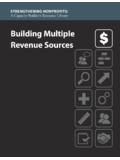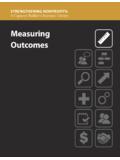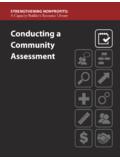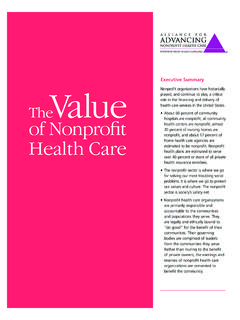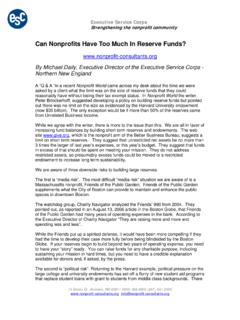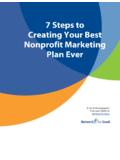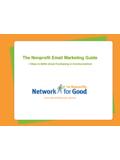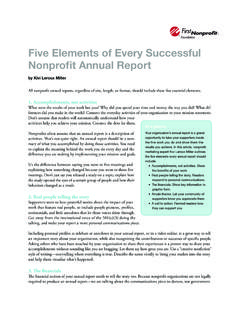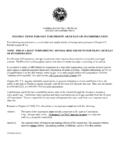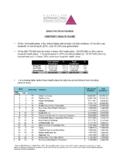Transcription of Leading a Nonprofit Organization - Strengthening …
1 Leading a Nonprofit Organization : Tips and Tools for Executive Directors and Team LeadersSTRENGTHENING NONPROFITS: A Capacity Builder s Resource LibraryTABLE OF CONTENTSINTRODUCTION ..3 OVERVIEW ..4 OPERATIONAL RESPONSIBILITIES OF THE EXECUTIVE DIRECTOR ..4 Becoming an Executive Director ..4 Designing, Developing, and Implementing Strategic Plans ..5 Hiring, Managing, and Retaining Staff ..6 Working with a Board of Directors ..8 Financial Management and Fundraising ..9 Leading TEAMS ..11 Leadership Styles ..11 Team Management and Performance Tools ..12 Exercises and Compassion Capital Fund (CCF), administered by the Department of Health and Human Services, provided capacity building grants to expand and strengthen the role of Nonprofit organizations in their ability to provide social services to low-income individuals. Between 2002 and 2009, CCF awarded 1,277 grants, and the CCF National Resource Center provided training and technical assistance to all CCF grantees.
2 Strengthening Nonprofits: A Capacity Builder s Resource Library is born out of the expansive set of resources created by the National Resource Center during that time period, to be shared and to continue the legacy of CCF s capacity building work. Strengthening Nonprofits: A Capacity Builder s Resource Library contains guidebooks and e-learnings on the following topics:1. Conducting a Community Assessment2. Delivering Training and Technical Assistance3. Designing and Managing a Subaward Program4. Going Virtual5. Identifying and Promoting Effective Practices6. Leading a Nonprofit Organization : Tips and Tools for Executive Directors and Team Leaders7. Managing Crisis: Risk Management and Crisis Response Planning8. Managing Public Grants9. Measuring Outcomes10. Partnerships: Frameworks for Working Together11. Sustainability12. Working with ConsultantsWho is the audience for Strengthening Nonprofits: A Capacity Builder s Resource Library?Anyone who is interested in expanding the capacity of Nonprofit services in their community from front line service providers to executives in large intermediary organizations will benefit from the information contained in this resource library.
3 The National Resource Center originally developed many of these resources for intermediary organizations, organizations that were granted funds by CCF to build the capacity of the faith-based and community-based organizations (FBCOs) they served. As such, the majority of the resources in Strengthening Nonprofits: A Capacity Builder s Resource Library support intermediary organizations in their capacity building efforts. However, funders of capacity building programs (Federal program offices and foundations) and the Nonprofit community (including FBCOs) at large will also find these resources helpful. In addition, individuals working to build capacity within a program or an Organization will be able to use these resources to support their efforts to implement change and make Leading a Nonprofit Organization guidebook will be helpful to new or current executive director or anyone Leading or managing a team/committee within a developed the Leading a Nonprofit Organization guidebook?
4 The guidebook was developed for the Department of Health and Human Services by the National Resource matter your title or role, there are plenty of opportunities while working at a Nonprofit Organization for you to serve as a leader. Whether you are directing a board, chairing a committee, managing a team, or coordinating a project, the goal is always the same to lead effectively. The structure of some nonprofits may mirror the corporate model, with a clearly defined chain of command, but many others, particularly smaller organizations, pursue their mission in a more unique fashion. Accordingly, this toolkit is divided into two main sections: Operational Responsibilities of the Executive Director and Leading Teams. The former provides practical tips and tools for the first-time executive, while the latter discusses leadership in broader terms offering insight and activities to help anyone become a stronger RESPONSIBILITIES OF THE EXECUTIVE DIRECTORAs the person in charge of the operations of a Nonprofit Organization , an executive director has many unique responsibilities.
5 Executive directors are charged with establishing and enforcing the vision of the Organization ; recruiting and supervising office staff; maintaining a productive relationship with the board of directors; creating a fundraising plan that will ensure sustainability; and managing organizational finances. Becoming an Executive DirectorStarting a new job is always an exhilarating experience, and Nonprofit directors have the power to effect real, lasting change. The first half of this toolkit offers tips and tools to help make your adoption of this new role as seamless as you are replacing a former executive director rather than starting your own Organization , it is important that your orientation occurs as part of a larger transitional plan. Because the executive director takes the lead in establishing an Organization s climate, work, and processes, assuming control can impact staff morale, board member engagement, and the perception of funders and clients. New Executive Director ChecklistHere s a quick list of the essential documents that a new executive director should gather together on the first day of work and keep in a management folder.
6 If these documents are not already available, you should make it a top priority during your first quarter on the job to get them developed. General Most recent annual report Strategic plan Staff contact sheet Board roster and contact information Board policies and procedures Minutes from recent board meetings Technology inventory5 Organizational conflict of interest policy Bylaws IRS determination letterHuman Resources Personnel handbook All job or position descriptions (including your own) Employee orientation manual and processFinancial Current fiscal year budget Current statement of financial position and activities Recent audit information (if applicable)Fundraising Funding matrix (with funder name, amounts, and report deadlines) Fundraising plan Recent proposal(s)Designing, Developing, and Implementing Strategic PlansAs an executive director, it is your responsibility to guide the Organization and provide a vision for where it will be in the immediate future and the long term.
7 This is achieved through the creation and implementation of a strategic planning charts a course for reaching your goals and evaluating your progress. Strategic planning is important because it provides an Organization s board, staff, and stakeholders with a universal blueprint for action. Every Nonprofit will have different needs for a strategic plan, depending upon the Organization s leadership, culture, and size. Sometimes strategic planning is less about making big, sweeping decisions and more about clarifying an Organization s top priorities. While board members, staff, clients, community members, and other stakeholders may play a role in forming the strategic plan, the process is often driven by the executive director. If there is a plan already in place, it is typically reviewed and implemented by the executive director. Design and DevelopmentPrior to the development of a strategic plan, you should determine a design process and identify dates of anticipated achievement.
8 You may also want to consider hiring an external a few simple rules will increase the likelihood that your strategic plan becomes an actionable one, rather than a document that collects dust: Involve the relevant people. Gather input from those upon whom you will rely to implement the plan. Break the plan into tasks. Although the plan should contain large, long-term goals, it is equally important to develop actionable steps for achieving them. Be realistic. It s okay to think big, but you should also think about what is realistically achievable based on the size and strength of your support you have a plan in hand, you are ready to put it into action. Here are a few helpful activities for implementing your strategic plan: Assign tasks and due dates. For more complex tasks, consider dividing them into smaller action items or assigning them to a work group or team. Insert the tasks into the most appropriate job descriptions and schedule performance reviews to monitor progress.
9 Distribute the plan in a format that is user-friendly and conducive to there is already a strategic plan in place when you assume the role of executive director, you will want to meet with both board members and staff to review the plan and discuss their reactions and experience. Specifically, you should survey the team on who contributed to the plan, how the plan has historically been implemented, and the perceived effectiveness of the plan. These conversations will help you determine the best way to move forward in implementing the , Managing, and Retaining StaffAn Organization is only as strong as its staff, so it is essential that you take a thoughtful approach and make informed decisions when recruiting new employees. Once you have a team in place (or if you are inheriting a preexisting staff ), it is equally important to engender mutual respect and commitment to the organizational mission. Whether you are the supervisor of a small team of middle managers or you directly oversee the entire staff, you will play a key role in staff recruitment, management, and retention.
10 Here we offer tips on writing an effective job description, managing smartly, and keeping your staff focused and DescriptionsBy providing a straightforward description of the position s key duties and requirements, a well-written employment listing will help applicants determine if they re a good match for the job and provide a framework for choosing the best candidate for the position. A job description can also prove useful in the orientation and supervision of a staff member, as it helps everyone in the Organization understand the boundaries of that person s responsibilities. For the employee and his/her supervisor, it also provides the framework for a performance development are several essential elements to crafting an effective job description:7 OverviewProvide a brief history. You might want to include when the Organization was founded, the organizational mission, and a list of your programs. ResponsibilitiesDescribe all of the duties associated with the position.
